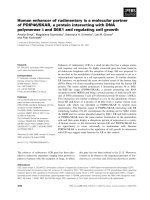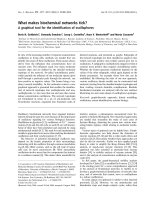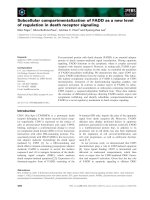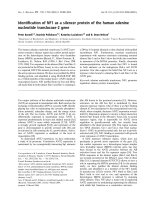Báo cáo khoa học: "Polyhedral representation of crown shape. A geometric tool for growth modelling" ppsx
Bạn đang xem bản rút gọn của tài liệu. Xem và tải ngay bản đầy đủ của tài liệu tại đây (672.68 KB, 10 trang )
Original
article
Polyhedral
representation
of
crown
shape.
A
geometric
tool
for
growth
modelling
C
Cluzeau
JL Dupouey
B
Courbaud
1
INRA,
unité
croissance,
production
et
qualité
des
bois,
54280
Champenoux;
2
INRA,
unité
d’écophysiologie
forestière,
54280
Champenoux;
3
CEMAGREF,
division
protection
contre
les
érosions,
BP
76,
38402
Saint-Martin-d’Hères
cedex,
France
(Received
14
March
1994;
accepted
17
January
1995)
Summary —
Tree
or
stand
growth
modelling
often
needs
an
explicit
representation
of
crown
shape.
This
is
necessary
for
crown
volume
or
external
surface
calculations,
or
light
penetration
modelling.
Many
different
representations
have
been
used
for
this
purpose.
In
this
paper,
we
explore
the
use
of
the
polyhedral
convex
hull
of
the
crown
as a
type
of
boundary
representation.
We
present
an
application
of
this
representation
for
the
calculation
of
geometrical
characteristics
of
common
ash
trees
(Fraxinus
excelsior L).
Crown
projection
area
calculated
with
the
convex
hull
is
closely
related
to
the
measured
value.
Moreover,
a
strong
relation
exists
between
the basal
area
of
the
most
external
tree
rings
and
the
convex
hull
volume
or
surface
area
which
indirectly
validates
the
polyhedral
representations.
This
relation,
however,
is
no
stronger
than
exists
with
the
simpler
crown
projection
surface
area
measure-
ment.
The
convex
hull
is
intermediate
in
terms
of
computation
costs
and
efficiency
between
classical
geometric
shapes
and
more
elaborate
computer
graphic
representations.
It
is
a
simple
and
versatile
tool for
modelling
purposes.
crown
shape
representation
/ computational
geometry
/ crown
volume
/ convex
hull
/ pipe
model
/ Fraxinus
excelsior
L
Résumé —
Représentation
polyédrique
de
la
forme
du
houppier.
Un
outil
géométrique
pour
la
modélisation
de
la
croissance.
La
modélisation
de
la
croissance
des
arbres
ou
des peuplements
fait
souvent
appel
à
une
représentation
géométrique
du
houppier.
Cela
est
nécessaire
pour,
par
exemple,
les
calculs
de
volume
et
de
surface
externe
du
houppier,
ou
la
modélisation
de
la
pénétration
de
la
lumière
dans
les peuplements.
De
nombreuses
représentations
ont été
utilisées jusqu’à
maintenant,
le
plus
souvent
une
combinaison
de
différents
solides
de
révolution.
Nous
explorons
dans
cet
article
les
possibilités
offertes
par
la
représentation
polyédrique
convexe
où
la
frontière
du
houppier
est
représentée
par
son
enveloppe
convexe.
Cette
représentation
est
appliquée
au
calcul
des
caracté-
ristiques
géométriques
de
houppiers
de
frênes
(Fraxinus
excelsior
L).
La
projection
au
sol
du
houppier,
calculée
à
partir
de
son
enveloppe
convexe,
est
très
proche
de
celle
mesurée
sur
le
terrain.
De
plus,
une
forte
relation
d’allométrie
apparaît
entre
l’accroissement
en
surface
terrière
des
cernes
les
plus
externes
du
tronc
et
le
volume
ou
la
surface
de
l’enveloppe
convexe
du
houppier.
Cette
liaison
est
maxi-
male
lorsque
l’accroissement
est
cumulé
sur
les
3
derniers
cernes
annuels.
Cependant,
elle
n’est
pas
meilleure
que
celle
observée
avec
la
surface
de
projection
au
sol
du
houppier,
plus
facilement
mesu-
rable.
Ces
relations
valident
indirectement
la
représentation
polyédrique
convexe.
Cette
représenta-
tion
est
un
compromis
intéressant,
en
termes
de
complexité
et
de
précision,
entre
les
solides
de
révo-
lution
classiques
et
les
représentations
volumiques
plus
élaborées.
forme
du
houppier / volume
du
houppier /enveloppe
convexe / géométrie
informatique / Fraxi-
nus
excelsior
L
INTRODUCTION
Crown
shape
is
a
key
factor
in
architectural
and
functional
tree
modelling.
The
crown
is
at
the
interface
between
the
tree
and
the
atmosphere
and
as
such
controls
the
inter-
ception
of
water,
light
and
pollutants.
It
inter-
acts
directly
with
other
trees
by
mechanical
contact
or
indirectly
by
shading.
Crown
shape
both
conditions
and
reflects
tree
eco-
physiological
functioning.
Many
geometric
characteristics
of
crown
shape
are
used
in
modelling
tree
or
stand
growth.
Crown
length
or
horizontal
exten-
sion
are
often
used
for
the
calculation
of
competition
indices.
Crown
volume
and
sur-
face
area
have
been
shown
to
be
closely
related
to
foliar
biomass
(Zeide
and
Pfeifer,
1991;
Jack
and
Long,
1992;
Makela
and
Albrekton,
1992)
or
bole
increment
(Mitchell,
1975;
Seymour
and
Smith,
1987;
Sprinz
and
Burkhart,
1987;
Ottorini,
1991).
Eco-
physiological
parameters
such
as
leaf
con-
ductance,
internal
CO
2
concentration
or
water
use
efficiency
are
significantly
corre-
lated
with
crown
volume
(Samuelson
et
al,
1992)
and
crown
surface
area
has
been
used
for
the
study
of
pollution
impacts
(see
eg,
Dong
et al,
1989).
Geometrical
and
topo-
logical
information
about
the
shape
of
the
crown
is
needed
to
model
mechanical
inter-
actions
between
trees
or
light
interception
within
stands.
Finally,
computer
graphics
also
need
the
use
of
such
data
for
the
syn-
thesis
of
realistic
tree
or
stand
pictures
(Reffye
et al,
1988).
Geometric
characteristics
are
most
often
obtained
from
the
position
of
a
few
distin-
guishing
points
of
the
crown,
such
as
the
top,
base
and
maximum
horizontal
exten-
sion
of
branches.
Length
(vertical
exten-
sion)
is
readily
calculated.
Horizontal
exten-
sion
is
sometimes
approximated
by
the
maximum
or
mean
width
of
the
crown,
but
more
often
ground
crown
projection
is
used.
Its
area
is
calculated
from
the
position
of
intersections
between
radii
centered
on
the
bole
and
the
crown
edge
projection.
Calcu-
lation
of
volume
of
external
surface
area
of
the
crown
needs
reference
to
an
explicit
representation
of
the
crown
boundary
shape.
Classical
forms
used
are
cylinders,
various
conics
and
vertical
or
radial
combinations
of
these.
Koop
(1989)
presents
an
extended
review
of
these
different
forms.
His
own
description
of
a
crown,
one
of
the
most
elab-
orate,
uses
the
measured
position
of
8
points
on
the
crown
boundary
to
fit
4
slices
of
ellipsoids.
However,
these
axisymmetrical
shapes
impose
heavy
constraints
on
the
repre-
sentation
of
the
crown
boundary.
A
more
relaxed
representation
can
be
obtained
using
a
set
of
points
selected
on
the
bound-
ary,
and
a
graph
of
proximity
on
this
set
of
points.
Various
geometric
structures
can
be
used
for
this
purpose
(Boissonnat,
1984).
In
this
paper,
we
explore
the
use
of
the
polyhedral
convex
hull
of
the
crown,
which
is
one
of
the
simplest
structures
and
has
not
yet
been
tested
for
crown
repre-
sentation.
Such
a
representation
can
be
used
as
a
by-product
of
architectural
mod-
els of
crown
development.
These
models
are
based
on
the
quantitative
analysis
of
tree
organization
at
the
branch
or
growth
unit
level
(see
eg,
Mitchell,
1975;
Ottorini,
1991;
Reffye
et al,
1991;
Prusinkiewicz
et al,
1993).
They
imply
the
precise
spatial
posi-
tioning
of
phytoelements
inside
the
crown.
Thus,
they
provide
the
set
of
data
neces-
sary
for
the
polyhedral
representation
of
crown
boundary.
We
present
an
application
of
this
poly-
hedral
representation
in
the
calculation
of
crown
shape
parameters
of
common
ash
(Fraxinus
excelsior
L).
To
verify
the
relia-
bility
of
this
representation,
we
also
study
the
classical
allometric
relationships
between
crown
dimensions
calculated
with
the
polyhedral
representation
and
radial
tree
growth
(see
eg,
Coyea
and
Margolis,
1992).
This
work
makes
use
of
data
initially
col-
lected
for
the
modelling
of
common
ash
growth
development
(Cluzeau
et al,
1994).
MATERIALS
AND
METHODS
Tree
sampling
and
measurements
Twenty-seven
common
ashes
were
sampled
in
various
forests
of
north-eastern
France.
Trees
were
chosen
in
order
to
represent
different
ages
and
crown
forms,
including
free
growing
trees
with
a
large
crown
as
well
as
crowded
trees
with
a
thinner
crown.
Before
cutting,
each
tree
was
measured
for
diameter
at
breast
height,
total
height,
crown
length
and
crown
projection
sur-
face
area.
This
latter
surface
was
delimited
with
a
plumbline,
from
the
branches
which
had
the
longest
horizontal
projection
all
around
the
tree.
Common
ash has
only
a
few
second
order
branches,
thus
8
to
12
branches
were
sufficient.
After
harvest,
annual
length
increments
(growth
units)
of
the
branches
and
the
stem
were
determined.
Boundaries
between
growth
units
were
localized
using
bud
scars.
Length,
diameter
and
age
of
each
growth
unit
were
determined.
For
each
main
branch,
making
up
the
basic
crown
framework,
the
azimuth
from
the
north
and
the
length
of
the
leafy
part
were
measured.
Second
order
branches,
directly
attached
to
the
bole,
were
distinguished
from
tertiary
branches
attached
to
the
secondary
branches.
From
these
data,
we
calculated
the
Cartesian
coordinates
(x,y,z)
of
the
origin
and
tip
of
each
growth
unit.
A
stem
analysis
gave
basal
area
(at
breast
height)
and
bole
vol-
ume
increments
for
each
year.
Disks
were
anal-
ysed
at
1
year
intervals
along
the
bole.
For
each
disk,
annual
radial
increments
were
measured
along
4
radii.
A
more
detailed
presentation
of
sampling
and
measurements
is
given
in
Cluzeau
et al (1994).
Calculation
of
the
polyhedral
representation
and
crown
shape
parameters
All
the
measured
points
delimiting
each
growth
unit
are
included
in
the
crown.
From
this
set
of
points,
we
calculated
the
crown’s
polyhedral
hull.
There
is
no
unique
solution
for
this
problem,
but,
among
all
possible
solutions,
the
convex
hull
is
the
simplest
and
also
has
some
properties
that
make
it
easy
to
manipulate.
By
definition,
the
poly-
hedral
convex
hull
is
the
smallest
convex
set
con-
taining
all
the
above
points.
For
any
pair
of
points
inside
a
convex
set,
the
segment
joining
these
2
points
is
entirely
inside
the
convex
set.
The
convex
hull
of
the
crown
was
calculated
using
the
gift
wrapping
algorithm
(Preparata
and
Shamos,
1985)
which
gives
a
triangulation
of
the
set
of
points
belonging
to
the
convex
hull.
Each
facet
of
this
convex
polyhedron
is,
by
construction,
a
triangle.
We
developed
an
application
software
for
the
calculation
of
convex
hulls
and
image
syn-
thesis.
This
representation
allows
the
calculation
of
various
form
parameters.
The
position
of
the
center
of
gravity
of this
polyhedron
was
calculated.
This
gives
informa-
tion
on
the
asymmetry
of
the
crown.
Crown
length
(CL)
is
the
difference
between
the
highest
and
lowest
point
ordinates.
Total
area
of
the
hull
(CS)
is
the
sum
of
the elementary
triangular
facet
areas.
Volume
(CV)
is
calculated
as
the
sum of
the
vol-
umes
of
elementrary
tetrahedra
based
on
each
facet
and
with
the
centrer
of
gravity
as
the
summit.
Crown
projection
surface
area
is
the
area,
on
a
horizontal
plane,
of
the
convex
hull
of
the
verti-
cal
projections
of
all
the
points
of
the
crown
con-
vex
hull.
The
surface
area
of
the
top
part
of
the
convex
hull
was
also
calculated
since
it
can
be
used
to
estimate
the
leaf
surface
exposed
to
sun.
This
surface
is
composed
of
all
the
facets
which
have
their
normal
vector
at
more
than
90°
above
the
horizontal.
Finally,
the
empty
interior
volume
of
the
crown
("bare
inner
core",
Jack
and
Long,
1992)
and
the
leafy
volume
were
estimated
with
the
same
convex
hull
approach
applied
to
the
set
of
points
delimiting
the
leafy
and
leafless
zones
of
the
branches
inside
the
crown.
Verifying
the
reliability
of
the
polyhedral
representation
In
order
to
verify
the
reliability
of
the
polyhedral
representation,
we
compared
crown
projection
surface
area
calculated
with
this
representation
to
that
measured
in
the
field.
Furthermore,
allomet-
ric
relationships
between
crown
volume
or
sur-
face
area
and
basal
area
or
bole
volume
incre-
ment
were
studied.
Correlation
coefficients
(r)
and
regression
equations
were
calculated
using
the
SAS
package
(SAS
Institute
Inc,
1989).
Both
raw
variables
and
their
squares
were
tested
in
the
regression
equations.
The
quality
of
fit
was
assessed
by
standard
error
of
the
estimates
and
adjusted
coefficient of
determination
(R
2
),
as
well
as
visual
inspection
of
the
residuals.
Although
consistent
with
all
the
calculated
regression
lines,
1
large
tree
was
removed
from
the
calculations
due
to
extreme
and
influential
values
for
all
vari-
ables.
RESULTS
Calculation
and
graphical
representation
of
the
polyhedral
representation
Figure
1
shows
1
tree
and
figure
2
its
poly-
hedral
convex
hull.
For
each
figure,
the
tree
is
represented
from
2
different
directions,
shifted
by
5°.
This
allows
the
reconstruction
of
a
3-D
view
of
the
tree
using
a
classical
stereoscope.
The
complexity
of
the
convex
hull
increases
with
the
number
of
branches
from
16
facets
for
the
smallest
tree
to
66
facets
for
the
biggest,
corresponding
to
10
and
35
points,
respectively
(table
I).
The
empty
interior
volume
is
small
compared
to
the
total
volume
(10%
on
average).
Calcu-
lated
values
of
volume
are
rather
low
in
com-
parison
with
values
observed
elsewhere.
Vrestiak
(1989)
observed
average
values
of
800
m3
for
free
growing
common
ashes
at
50
years
old.
Allometric
relationships
between
crown
dimensions
and
growth
Figure
3
gives
the
relationship
between
the
measured
and
calculated
crown
projection
surface
area.
The
correlation
is
very
high
(r=
0.98),
indicating
that
our
representation
gives
a
valid
view
of
the
real
crown,
in
2-D
space
at
least.
A
slight
underestimation
occurs
for
the
largest
trees,
above
25
m2
of
the
crown
projection
surface
area.
Table
II
gives
the
linear
correlation
coef-
ficients
between
various
crown
shape
parameters
calculated
with
our
convex
rep-
resentation
(surface
area
and volume
of
the
external
convex
hull,
crown
projection
sur-
face
area)
and
measurements
of
tree
growth
(annual
basal
area
and
bole
volume
incre-
ments).
A
strong
allometric
relation
exists
between
the
measured
tree
basal
area
and
calculated
crown
surface
area
(r=
0.82)
or
volume
(r=
0.81).
However,
the
correlation
is
even
better
with
measured
crown
projec-
tion
surface
area
(r=
0.89).
Interestingly,
the
correlation
of
surface
area,
volume
of
the
convex
hull,
or
the
crown
projection
surface
area,
with
squared
basal
area
increment
cumulated
from
the
most
external
ring
over
the
last
10
years,
reaches
a
maximum
for
the
3
external
rings
(r=
0.93
with
the
convex
hull
surface
area,
r=
0.92
with
its
volume,
and
r=
0.93
with
measured
crown
projection
surface
area).
It
is
inter-
esting
to
note
that
this
relationship
(fig
4)
holds
for
all
trees
in
our
sample,
either
free
growing
or
suppressed.
An
analysis
of
the
residuals
of
this
regression
shows
that
over-
estimation
of
the
crown
volume
occurs
when
very
low
branches
are
developed
down
the
main
stem.
In
this
occurrence
of
outliers,
convexity
assumes
the
presence
of
a
con-
tinuous
layer
of
leaves
from
these
low
branches
upwards,
whereas
these
branches
are
isolated
at
the
base
of
the
tree,
without
any leaves.
The
equations
of
the
regression
lines
are:
where
CS
is
the
convex
hull
surface
area
(m
2
),
CV
is
the
convex
hull
volume
(m
3
),
and
BAI
is
the
squared
surface
increments
of
the
3
most
external
rings
at
breast
height
(dm
2
).
These
2
relations
present
an
efficient
way
to
rapidly
calculate
crown
volume
and
surface
area
based
on
simple
measure-
ments
of
external
tree-ring
increments.
Neither
the
top
part
of
the
crown
surface
nor
the
leafy
volume
were
better
correlated
with
radial
growth
than
total
crown
surface
and
volume
(table
II).
These
relations
were
not
improved
by
removing
3rd
order
branches
from
the
convex
hull
calculation.
DISCUSSION
Crown
projection
surface
area
is
the
only
measurement
we
have
to
directly verify
the
validity
of
our
representation.
The
agree-
ment
between
measured
and
calculated
val-
ues
is
very
high.
However,
this
is
only
a
2-D
validity
test
of
our
3-D
representation.
Valid-
ity
of
the
polyhedral
representation
is
also
strengthened
by
the
very
strong
correlation
we
observed
between
current
increments
at
breast
height
and
both
crown
surface
area
and
volume.
This
relationship
between
conducting
and
evaporating
surfaces
(the
so-called
pipe
model)
has
been
extensively
documented
(see
Coyea
and
Margolis,
1992).
It
is
a
consequence
of
the
fact
that
hydraulic
conductance
in
stems
is
the
prod-
uct
of
conducting
tissue
area
multiplied
by
the
specific
conductivity
of
these
tissues.
For
ash
trees,
the
relationship
is
better
with
a
squared
value
of
conducting
surface
area.
This
is
in
accordance
with
the
theoretical
hydraulic
conductance,
given
by
the
Hagen-
Poiseuille
equation,
which
is
proportional
to
the
4th
power
of
the
capillary
radius
(Ewers
and Zimmermann,
1984).
correlation
of
both
crown
volume
and
surface
area
is
highest
with
the
area
of
the
last
3
annual
rings.
This
suggests
that
water
flow
in
common
ash
could
be
restricted
to
these
external
rings
rather
than
stretching
throughout
the
sapwood.
A
sim-
ilar
observation
was
made
for
oaks
(Rogers
and
Hinckley,
1979)
and
Norway
spruce
(Sellin,
1993),
and
direct
measurements
confirmed
the
assumption
for
oaks
(Granier
et al,
1994).
Hence,
the
functional
value
of
the
morphologically
defined
sapwood
as
an
indicator
of
xylem
conductive
surface
is
sus-
pect
and
the
necessity
of
direct
measure-
ments
of
water
flow
area
within
the
trunk
is
made
apparent.
However,
the
calculated
crown
external
surface
area
is
not
a
better
predictor
of
radial
growth
then
the
measured
crown
projection
surface
area.
This
means
that,
for
a
growth
model
of
common
ash
using
an
allometric
relationship
between
radial
increment
of
bole
and
crown
structure,
the
simple
mea-
surement
of
the
crown
projection
surface
area
gives
a
sufficient
estimation.
On
the
contrary,
Maguire
and
Hann
(1988)
observed
a
better
correlation
of
sapwood
area
with
crown
surface
area
then
with
sim-
pler
variables.
The
polyhedral
representation
is
theo-
retically
more
precise
than
that
of
the
axisymmetrical
solids
because
the
real
crown
shape
is
often
randomly
built
by
con-
tacts
with
neighbors,
shading
or
illumina-
tion
and
various
injuries
(insect
attacks,
snow
and
ice
damage,
etc).
Developmental
asymmetry
can
be
very
important.
Thus,
the
polyhedral
representation
is
closer
to
the
real
shape.
Whereas
no
overestimation
of
crown
surface
area,
volume
nor
crown
projection
surface
area
was
apparent
in
our
results,
the
polyhedral
representation
is
sen-
sitive
to
extreme
outliers.
This
could
be
improved
by
calculating
non-convex
hulls,
thus
allowing
the
representation
to
account
for
depressions
on
the
crown
boundary
(Boissonnat,
1984).
Finally,
convexity
seems
to
be
an
acceptable
constraint
on
the
rep-
resentation
of
crown
shape
since
concave
shapes
are
seldom
observed
in
nature,
especially
for
broadleaves
(Koop,
1989).
The
intrisic
limit
of
the
polyhedral
repre-
sentation
is
that
it
is
only
a
boundary
rep-
resentation
of
the
crown.
Thus,
the
internal
distribution
of
leaves
inside
the
crown
is
assumed
homogeneous.
Rather
than
homo-
geneous,
this
distribution
could
be
fractal
(Zeide
and
Pfeifer,
1991).
The
architectural
arrangement
of
foliage
in
the
tree
crowns
has
been
shown
to
strongly
control
radia-
tion
absorption,
photosynthesis
and
tran-
spiration
(Wang
and
Jarvis,
1990;
White-
head
et
al,
1990).
Non-boundary
representations,
such
as
the
computer
tech-
nique
of
voxel
space,
can
handle
the
inter-
nal
heterogeneity
of
distribution
of
phy-
toelements
(Green,
1989).
However,
the
need
for
such
more
elab-
orated
representations
of
the
crown
depends
on
the
study
scale
and
final
objectives.
Poly-
hedral
representation
is
very
efficient
in
terms
of
computation
time
and
memory
space
requirements
for
computer
graphics
and
calculations
of
light
penetration
at
the
stand
level.
It
is
less
demanding
than
voxel
representations.
Computation
requirements
and
accuracy
of
representation
for
the
dif-
ferent
methods
are
roughly
opposed
and
correlated
with
the
number
of
points
used
for
the
crown
representation,
from
8
points
in
the
Koop’s
model
(1989),
to
10-35
points
for
our
polyhedral
representation,
to
hun-
dreds
of
points
in
voxel
spaces.
Therefore,
the
polyhedral
representation
offers
an
inter-
esting
alternative
to
these
solutions.
Due
to
the
large
number
of
data
needed
for
its
cal-
culation,
it
is
best
suited
when
the
position
of
growth
units
within
the
crown
is
already
known,
either
from
previous
measurements
or
as
a
by-product
of
an
architectural
model
of
crown
development.
ACKNOWLEDGMENTS
The
authors
are
indebted
to
JM
Ottorini
and
N
Le
Goff
who
were
involved
in
the
initial
steps
of
this
work.
We
also
thank
R
Canta
and
L
Garros
for
technical
assistance
during
sampling
and
mea-
surements.
REFERENCES
Boissonnat
JD
(1984)
Geometric
structures
for
three-
dimensional
shape
representation.
ACM
Trans
Graph
3, 266-286
Cluzeau
C,
Le
Goff
N,
Ottorini
JM
(1994)
Development
of
primary
branches
and
crown
profile
of
Fraxinus
excelsior L.
Can
J
For
Res
24, 2315-2323
Coyea
MR,
Margolis
HA
(1992)
Factors
affecting
the
relationship
between
sapwood
area
and
leaf
area
of
balsam
fir.
Can
J
For
Res
22,
1684-1693
Dong
PH,
Laar
A
Van,
Kramer
H
(1989)
[A
model
for
research
on
forest
decline]
in
German.
Allg
Forst
Jagdztg
160, 28-32
Ewers
FW,
Zimmermann
MH
(1984)
The
hydraulic
archi-
tecture
of
eastern
hemlock
(Tsuga
canadensis).
Can
J Bot 62,
940-946
Granier
A,
Anfodillo
T,
Sabatti
M
et
al
(1994)
Axial
and
radial
water
flow
in
the
trunk
of
oak
trees:
a
quanti-
tative
and
qualitative
analysis.
Tree
Physiol 14, 1383-
1396
Green
N
(1989)
Voxel
space
automata:
modelling
with
stochastic
growth
processes
in
voxel
space.
Comput
Graph 23, 175-184
Jack
SB,
Long
JN
(1992)
Forest
production
and
the
organization
of
foliage
within
crowns
and
canopies.
For
Ecol
Manage
49,
233-245
Koop
H
(1989)
Forest
dynamics -
A
comprehensive
monitoring
system.
Springer-Verlag,
229
p
Maguire
DA,
Hann
DW
(1989)
The
relationship
between
gross
crown
dimensions
and
sapwood
area
at
crown
base
in
Douglas
fir.
Can
J
For
Res
19,
557-565
Makela
A,
Albrekton
A
(1992)
An
analysis
of
relation-
ship
between
biomass
and
crown
surface
area
in
Pinus
sylvestris
in
Sweden.
Scand
J
For
Res
7, 297-
307
Mitchell
KJ
(1975)
Dynamics
and
simulated
yield
of
Dou-
glas
fir.
For
Sci
Monogr
17,
39
p
Ottorini
JM
(1991)
Growth
and
development
of
individual
Douglas
fir
in
stands
for
applications
to
simulation
in
sylviculture.
Ann
Sci
For 48,
651-666
Preparata
FP,
Shamos
MI
(1985)
Computational
geo-
metry.
Springer-Verlag,
398
p
Prusinkiewicz
PW,
Remphrey
WR,
Davidson
CG,
Ham-
mel
MS
(1993)
Modeling
the
architecture
of
expand-
ing
Fraxinus
pennsylvanica
shoots
using
L-systems.
Can J Bot
72,
701-714
Reffye
P
de,
Edelin
C,
Francon
J,
Jaeger
M,
Puech
C
(1988)
Plant
models
faithful
to
botanical
structure
and
development.
Communication
SIGGRAPH’88,
Atlanta,
GA,
USA
Reffye
P
de,
Elguero
E,
Costes
E
(1991)
Growth
units
construction
in
trees:
a
stochastic
approach.
Acta
Biotheor 39,
325-342
Rogers
R,
Hinckley
TM
(1979)
Foliar
weight
and
area
related
to
current
sapwood
area
in
oak.
For
Sci 25,
298-303
Samuelson
LJ,
Seiler
JR,
Feret
PP
(1992)
Gas
exchange
and
canopy
structure
of
9-year-old
loblolly
pine
pitch
pine
and
pitch
x
loblolly
hybrids.
Trees
6, 28-31
SAS
Institute
Inc
(1989)
SAS/STAT
User’s
Guide,
Ver-
sion
6.
SAS
Institute
Inc,
Cary
NC,
USA,
943+846
p
Sellin
A
(1993)
Resistance
to
water
flow
in
xylem
of
Picea
abies
(L)
Karst
trees
grown
under
contrasting
light
conditions.
Trees 7,
220-226
Seymour
RS,
Smith
DM
(1987)
A
new
stocking
guide
formulation
applied
to
eastern
white
pine.
For
Sci
33, 469-484
Sprinz
PT,
Burkhart
HE
(1987)
Relationships
between
tree
crown,
stem,
and
stands
characteristics
in
unthinned
loblolly
pine
plantations.
Can
J
For
Res
17,
534-538
Vrestiak
P
(1989)
[Aerial
and
spatial
development
of
foliage
mass
of
European
ash
(Fraxinus
excelsior
L)]
in
Slovak.
Lesnictvi
(Czechoslovakia)
35,
115-
129
Wang
YP,
Jarvis
PG
(1990)
Influence
of
crown
struc-
tural
properties
on
PAR
absorption,
photosynthesis,
and
transpiration
in
Stika
spruce:
application
of
a
model
(MAESTRO).
Tree
Physiol 7,
297-316
Whitehead
D,
Grace
JC,
Godfrey
MJS
(1990)
Architec-
tural
distribution of
foliage
in
individual
Pinus
radi-
ata
crowns
and
the
effects
of
clumping
on
radiation
interception.
Tree Physiol 7,
135-155
Zeide
B,
Pfeifer
P
(1991)
A
method
for
estimation
of
frac-
tal
dimension
of
tree
crowns.
For Sci 37,
1253-1265









